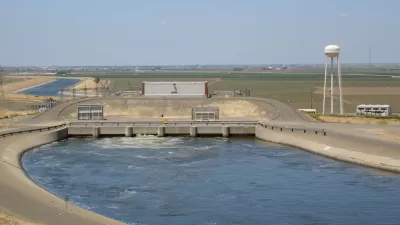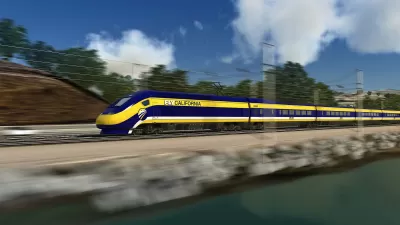'Huge' is an understatement. Revenues were less than 2 percent of what was forecasted. The uncertainty of the continuance of the program may be responsible. The plummet in revenues to high-speed rail adds to uncertainty of the $64 billion project.
The nation's only cap-and-trade program run by a state suffered an unanticipated setback when insufficient buyers purchased carbon allowances at the quarterly auction this month.
"The results of last week’s quarterly auction were posted [PDF] and revealed that instead of the $500-plus million expected from the sale of state-owned allowances, the state will get only about $10 million, less than 2 percent," writes Dan Walters, columnist for The Sacramento Bee.
The poor results confirmed reports circulating in financial circles that the cap-and-trade program has begun to stumble...but whether it’s a one-time dip or the harbinger of a more permanent down-market is uncertain.
[Gov.] Brown has submitted a plan to spend $3.1 billion in auction proceeds in 2016-17, both leftover funds from past auctions and an estimated $2 billion from those during the fiscal year. The plan covers a wide variety of projects and programs [see below], including a major allocation to support the state’s high-speed rail project.
High-speed rail
"The quarterly auction, conducted May 18 and announced [May 25], will provide just $10 million for state programs, including $2.5 million for the bullet train," writes Ralph Vartabedian for the Los Angeles Times. "The rail authority had been expecting about $150 million."
Whatever prompted the lack of buyers, the auction is a stark example of the uncertainty and risk of relying on actively-traded carbon credits to build the bullet train, a problem highlighted in recent legislative testimony by the Legislative Analyst's Office and a peer-review panel for the $64-billion high-speed rail.
The rail authority's recently released 2016 business plan had counted on getting about $10.6 billion from the greenhouse gas fees through 2050, about half of it by borrowing on the future income stream in about 2025.
"How all this affects high-speed rail’s budget is uncertain," writes Melody Gutierrez for the San Francisco Chronicle.
Jessica Peters, principal fiscal and policy analyst for the Legislative Analyst’s Office, said the rail authority is mostly relying on federal money now, but plans to use cap-and-trade revenue once it begins building its planned line to San Jose.
Peters said the analyst’s office found it problematic that the rail authority’s business plan relies heavily on the cap-and-trade revenue in future years, particularly given that the program is authorized only through 2020.
Effect will be felt on other programs as well.
The reduction in revenue will be felt by affordable housing programs, the state Transit and Intercity Rail Capital Program, efforts to reduce carbon emissions by transit agencies and the Low Carbon Transportation Investments and Air Quality Improvement Program run by the California Air Resources Board (CARB).
Future of cap-and-trade
While the California Air Resources Board states that it shall continue the program after the authorizing legislation, AB 32, the California Global Warming Solutions Act of 2006, ends in 2020, there is some degree of uncertainty. The landmark legislation called for reducing state greenhouse gas emission to 1990 levels by 2020. The legislature attempted unsuccessfully to renew the legislation last year.
"There’s a fierce, albeit mostly private, debate over whether the cap-and-trade system can legally exist after 2020, or would have to be reauthorized by the Legislature," adds Walters. "Meanwhile, there’s a pending lawsuit, filed by business groups, that seeks to have the system branded a tax, which would require a two-thirds legislative vote."
Vartabedian lists three reasons for the dramatic drop in revenues, with one being positive from a climate change perspective: AB 32 is working, and major emitters have dramatically cut emissions. However, the explanation could be simpler:
David Clegern, a spokesman for the state Air Resources Board, said he believed the auction results reflected simple volatility.
FULL STORY: California carbon emission auction proceeds fall short

Planetizen Federal Action Tracker
A weekly monitor of how Trump’s orders and actions are impacting planners and planning in America.

Maui's Vacation Rental Debate Turns Ugly
Verbal attacks, misinformation campaigns and fistfights plague a high-stakes debate to convert thousands of vacation rentals into long-term housing.

San Francisco Suspends Traffic Calming Amidst Record Deaths
Citing “a challenging fiscal landscape,” the city will cease the program on the heels of 42 traffic deaths, including 24 pedestrians.

Amtrak Rolls Out New Orleans to Alabama “Mardi Gras” Train
The new service will operate morning and evening departures between Mobile and New Orleans.

The Subversive Car-Free Guide to Trump's Great American Road Trip
Car-free ways to access Chicagoland’s best tourist attractions.

San Antonio and Austin are Fusing Into one Massive Megaregion
The region spanning the two central Texas cities is growing fast, posing challenges for local infrastructure and water supplies.
Urban Design for Planners 1: Software Tools
This six-course series explores essential urban design concepts using open source software and equips planners with the tools they need to participate fully in the urban design process.
Planning for Universal Design
Learn the tools for implementing Universal Design in planning regulations.
Heyer Gruel & Associates PA
JM Goldson LLC
Custer County Colorado
City of Camden Redevelopment Agency
City of Astoria
Transportation Research & Education Center (TREC) at Portland State University
Jefferson Parish Government
Camden Redevelopment Agency
City of Claremont




























